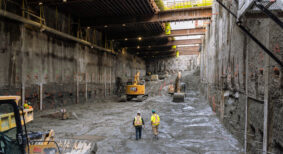How can the construction industry deliver better projects faster, more sustainably and with a smaller workforce? The answer is prefabrication.
Prefabrication or off-site construction is not new, but current challenges have sparked a renewed interest in the methodology.
According to Craig Mitchell, principal, BlackBox Offsite Solutions, prefabrication offers tremendous opportunities.
Mitchell, a modular building professional with more than 25 years of experience in the field, said during a Buildex Vancouver session that there are many opportunities to increase the use of prefabrication in Canada. Of the different methods of prefabrication, mass timber is seeing the most broad sector demand.
“Mass timber only makes up one per cent of the overall construction materials market here in North America but is growing 40 per cent year over year,” he said, going on to explain that a movement toward panel prefabrication (closed panels) is possible in the future but the market is in its infancy and is extremely fragmented.
Prefabrication offers many advantages to build more efficiently, helping to address challenges the construction industry is facing. One of the most pressing is the shortage of skilled labour which impacts other issues such as productivity and quality.
“The construction industry is among the worst performing industries in terms of productivity over the last two decades,” he said. “With prefabrication, the opportunities for erecting a building with a smaller workforce are there.”
With the ongoing labour shortage and inadequate supervision on project sites, moving projects into a climate-controlled factory setting offers considerably better quality control.
“By moving the construction process to a controlled environment, it forces you to get your design done early which locks in your costs. Prefabrication forces you to be very diligent in terms of getting all your work done in advance before you start construction,” said Mitchell, noting that helps consultants who are often overworked which leaves contractors in the field to figure things out.
Another important driver for more off-site construction technology is the increasing emphasis on sustainability. Changes in building codes and net zero targets will push construction towards prefabrication and accelerate growth, said Mitchell, adding off-site construction can also expedite project schedules up to 50 per cent and provide schedule certainty.
Demand is coming from sectors such as healthcare, hospitality, student accommodation, and affordable housing. All are seeing the benefits of speed and standardization with prefab technology and automation.
Meeting housing supply is a huge opportunity, said Mitchell, citing that the federal government has committed to build about 400,000 homes annually but only about 260,000 new homes are currently built each year, according to CMHC data.
“We are not going to build our way toward housing by using our existing labour force. We have to think differently,” he said.
But there are challenges and constraints for widespread adoption. Firstly, there is a general lack of experience and understanding on how to use prefabrication.
“Prefabrication is expected to fit into the traditional construction process,” said Mitchell. “Prefabrication doesn’t work well in that current environment. We have to find a way to develop a playbook for integration of prefabrication into traditional construction.”
Other challenges include:
- Transportation/logistics – modular construction has constraints around size and widths of loads. Early determination of logistics, storage, staging and weatherproofing is required.
- Contracts – Design-bid-build contracts typically do not work with prefabrication. More integrated and collaborative contracts such as integrated project delivery (IPD) and construction management work well.
- Insurance – Owners are still seeing increased insurance premiums. This means more education around the fire ratings and the properties of mass timber is required.
Mitchell cautioned that “project teams must address water management throughout construction and have a water mitigation plan” to avoid project failures.
When it comes to cost, prefabrication is more expensive than traditional construction.
“People think we can build cheaper using prefabrication – we’re not there yet. It’s more expensive,” said Mitchell, noting upfront costs are higher. “The industry still operates on hard costs. The way that prefabrication will have an advantage in the future is if we’re able to quantify the benefits. It’s the only way to compete against traditional construction.”
The speed and time advantage of prefab is also being lost due to current red tape and permit delays at city hall.
To promote prefabrication, case studies and best practices are required.
“We have to find a way to create that best practices guide so that we can start accelerating adoption in that sector,” urged Mitchell, noting mass timber has done a “fantastic marketing job” but modular and panelized construction need similar attention.
Other recommendation offered were:
- Reframe mass timber and panels as a single industry for market development.
- Revamp public sector procurement practices.
- Standardize terms and conditions and contract language.
- Encourage government and industry to work together to develop policies that specifically support off-site construction.
Mitchell stressed that for owners to adopt prefabrication, failures have to be minimized and successes championed. “If you’re new to prefabrication, I recommend bringing in your ‘A’ team for your first project. Talk to people who’ve done it. We want people to adopt prefabrication.”
Cheryl Mah is managing editor of Construction Business.









